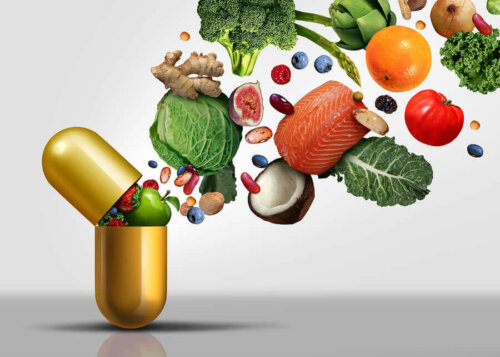Are there Benefits to Genetically Modified Food?


Written and verified by the biologist Samuel Antonio Sánchez Amador
Genetically modified food (GMO) is more common than ever. Still, people often view it as the product of a dystopian society. Thus, there’s a tendency to reject it. After all, modifying something as established as the genetic code of our surroundings can’t be good, right?
Thus, different interviews revealed that the rejection of these types of food is fairly high among the population. This is because 33.4% of those interviewed think they provide more harm than benefits, while their acceptance is only 22.8%.
There are still mixed feelings on this topic, but first, let’s be clear as to what a GMO actually is.
What’s genetically modified food?
Genetically modified food is food resulting from an organism modified by genetic engineering. In these foods, genes from another living being have been incorporated to produce the desired characteristic. Therefore, not all commercial foods have this characteristic.
Also, it’s important to differentiate between genetic and transgenic selection. Many types of food are products of the intentional crossing of plants with the best possible genetics. (Those with the largest seeds, the most striking fruits, the best colors, etc.). These aren’t transgenic, though.
To meet this condition, their genome must’ve been artificially modified somehow.
This may sound complex. In fact, it is! Therefore, we’ll limit the explanation of how companies produce transgenic food to its most basic concepts:
- First, the bacterium Agrobacterium tumefaciens has the ability to transfer genetic information to plants. It enters through any lesions these might have. They go into the intercellular spaces and introduce genetic information in the form of a plasmid. This integrates into some areas of the plant’s genome.
- Thus, this bacterium acts as a vehicle for the transmission of DNA. The plasmid it transmits has been modified in advance by introducing genetic information to it (other bacteria with the desired characteristic).
- Therefore, it forms a new, transgenetic food.
This formula is a simple way to understand one of the most widespread methods of transgenic production.

You may also be interested Eight Carcinogenic Foods that You Should Stop Eating
What benefits do transgenic foods provide?
Multiple studies, such as one published in the Journal of the Royal Society of Medicine, capture the benefits of genetically modified foods.
First of all, one must take into account that there are more than 840 million people on the threshold of poverty on the planet. Furthermore, they seldom reach a daily caloric intake of 2,000 kilocalories. Thus, human action is necessary to source resources.
- GMOs can provide a greater nutritional contribution. A clear example of this is golden rice, which geneticists modified to facilitate the synthesis of vitamin A, especially in developing countries where it’s impossible to have a balanced diet. In fact, 72 grams of this rice represents 50% of the recommended dose of vitamin A in a 3-year-old child.
- Genetical engineering facilitates the production of food. There are pest- and disease-resistant transgenic crops, so fewer plants spoil. This represents a greater economic benefit for farmers and more food availability.
- It helps create crops with greater resistance to climate change. This point is still in the laboratory phase, but it’s necessary to prepare crops genetically to counteract the effects which will occur as a consequence of climate change in the upcoming years.

You may also be interested The Pegan Diet – What You Should Know
Is genetically modified food dangerous?
In regards to the health of the general public, there’s no scientific proof of tangible danger in transgenics according to the World Health Organization (WHO).
Also, there’s no evidence that GMOs cause cancer, either. Also, these types of food undergo extensive testing, especially to prevent toxicity and allergenic effects in the general population. So far, no publicly authorized GM food has ever presented adverse actions.
Of course, not everything is good news. There’s always a risk that modified crops will cross-pollinate with other less desired vegetables and this could create imbalances in the natural ecosystem. Those vegetables that show resistance to pests may also end up negatively affecting other species.
Not everything is good in the world of transgenics. This is because they can cause detrimental effects on natural ecosystems and the species that live in them. Furthermore, there’s a risk of monopolizing food resources, in which only those with access to these techniques will succeed in the future markets.
As you’ve seen in this article, transgenic foods have a bad reputation. They’re very subject to scrutiny. However, they have both good and bad qualities. The question is: Will we be able to live without them in the near future on an overpopulated planet threatened by climate change?
The debate is still open.
All cited sources were thoroughly reviewed by our team to ensure their quality, reliability, currency, and validity. The bibliography of this article was considered reliable and of academic or scientific accuracy.
- Genetically modified plants and human health, Journal of the royal society of medicine. Recogido a 23 de mayo en https://www.ncbi.nlm.nih.gov/pmc/articles/PMC2408621/
- Bawa AS, Anilakumar KR. Genetically modified foods: safety, risks and public concerns-a review. J Food Sci Technol. 2013;50(6):1035‐1046. doi:10.1007/s13197-012-0899-1
- Maghari BM, Ardekani AM. Genetically modified foods and social concerns. Avicenna J Med Biotechnol. 2011;3(3):109‐117.
- Kamle M, Kumar P, Patra JK, Bajpai VK. Current perspectives on genetically modified crops and detection methods. 3 Biotech. 2017;7(3):219. doi:10.1007/s13205-017-0809-3
-
National Academies of Sciences, Engineering, and Medicine; Division on Earth and Life Studies; Board on Agriculture and Natural Resources; Committee on Genetically Engineered Crops: Past Experience and Future Prospects. Genetically Engineered Crops: Experiences and Prospects. Washington (DC): National Academies Press (US); 2016 May 17. 5, Human Health Effects of Genetically Engineered Crops. Available from: https://www.ncbi.nlm.nih.gov/books/NBK424534/
This text is provided for informational purposes only and does not replace consultation with a professional. If in doubt, consult your specialist.








